Shipping
The content below is directly from WooCommerce.
Ensuring you have the most accurate instructions.
Set Up Shipping Labels

- Go to WooCommerce > Settings > Shipping > WooCommerce Shipping & Tax > Shipping Labels.
- Select a Paper size from the dropdown.
- Payment.
- Add a credit card, if one is not already stored on your WordPress.com account. A method of payment must be on file if you wish to print labels.
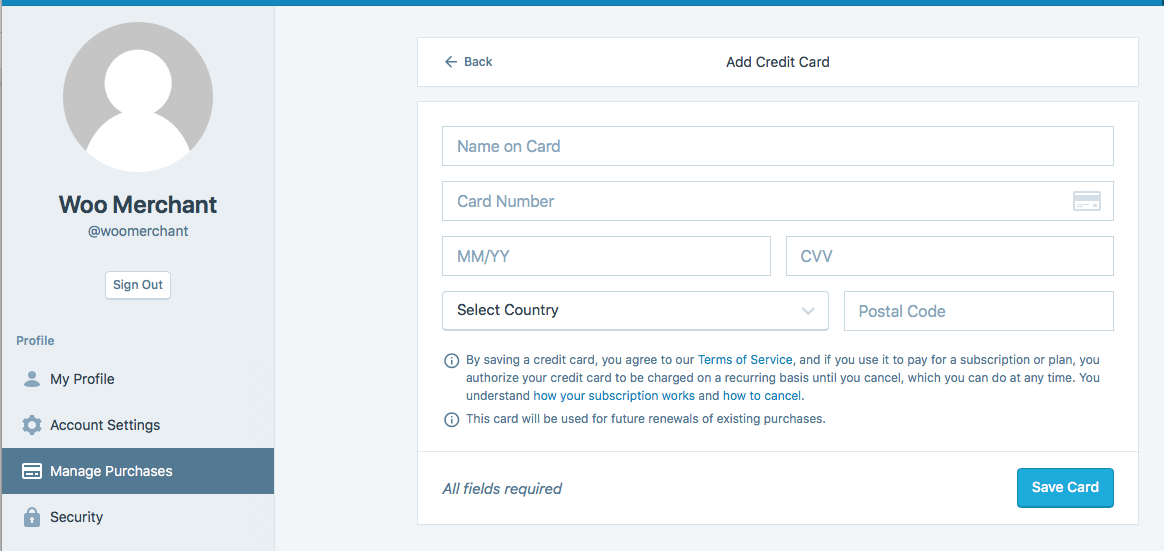
- Choose a different card, if one is on file at your WordPress.com account and you wish to use another.

- Skip this step: It’s also possible to bypass and enter nothing, and be prompted to add a payment method later when you’re ready to Print Shipping Labels (below).
- Tick or untick the box for Email Receipts.
- Save changes.
Manage Packages
Custom packaging
- Go to WooCommerce > Settings > Shipping > WooCommerce Shipping & Tax > Packages.
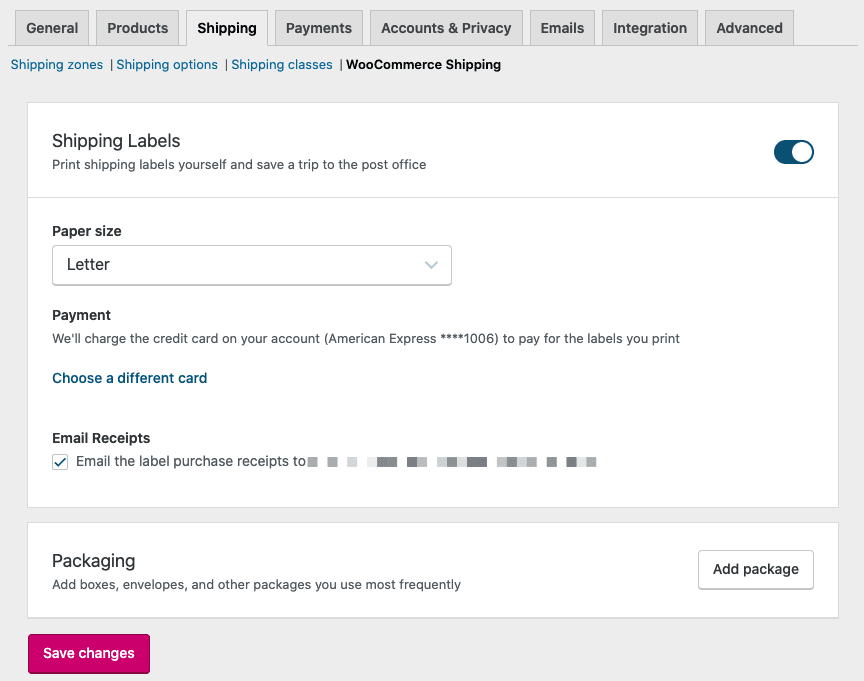
- Select Add package. The Add a Package screen displays.
- Select Type of package from the dropdown.
- Enter a Package name to identify it.
- Enter Dimensions and Weight.
- Add package.
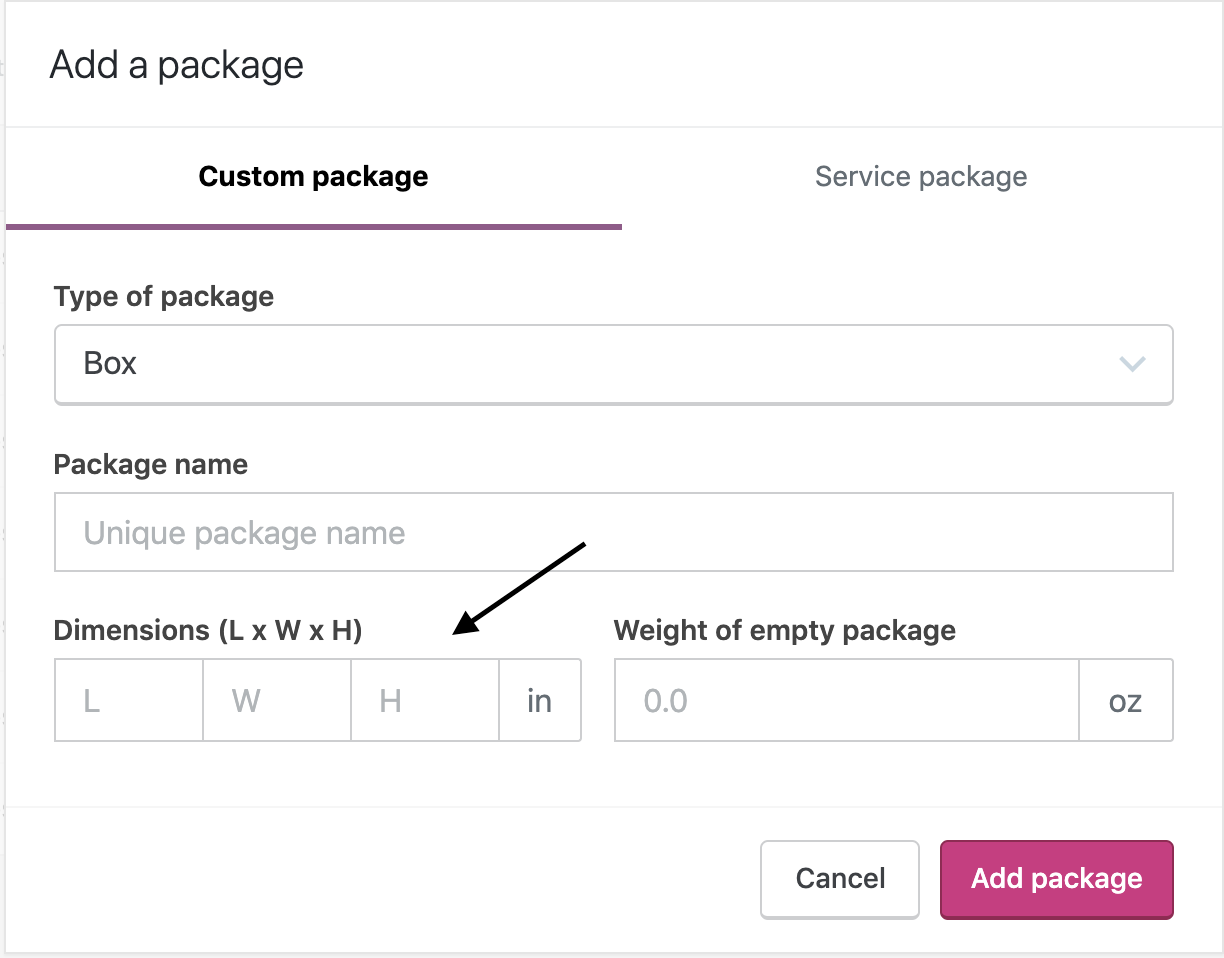
Carrier-provided packaging
You can opt to use the boxes and envelopes provided by carriers. Many carriers offer those supplies for free.- Go to WooCommerce > Settings > Shipping > WooCommerce Shipping & Tax > Packages.
- Select Add package. The Add a Package screen displays.
- Select Service package and tick the box of one or more of the options available from the courier.
- Add packages.
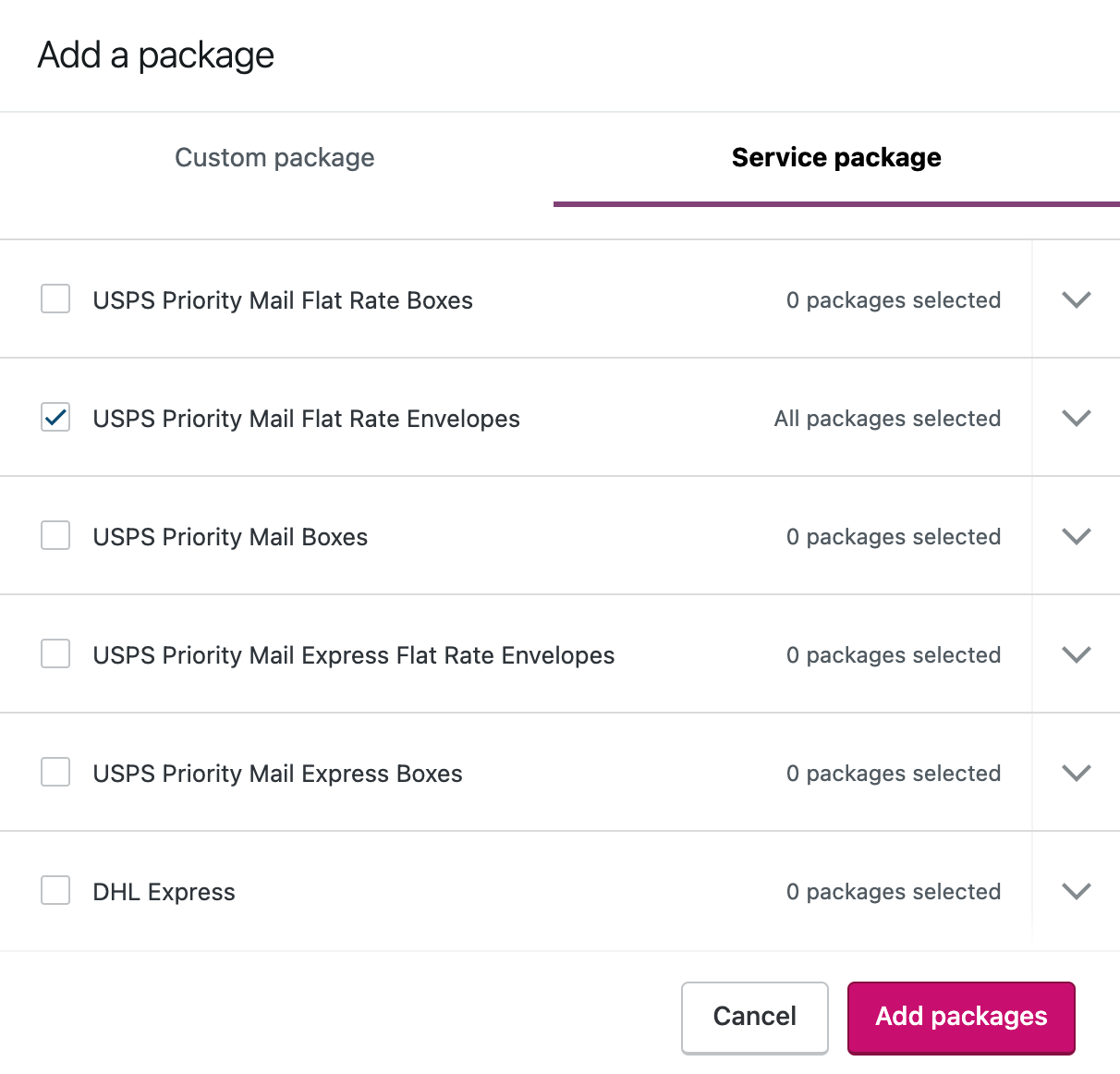
Print Shipping Labels
- Go to WooCommerce > Orders and select an order to fulfill. On the order details screen is a Shipping Label metabox at the top:
 Most WooCommerce shipping method extensions show the rate chosen by the customer and packaging information below the order details:
Most WooCommerce shipping method extensions show the rate chosen by the customer and packaging information below the order details:
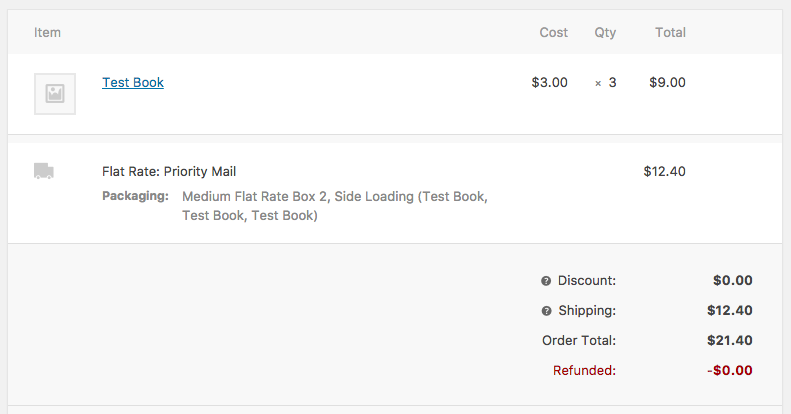
- Select Create shipping label
- Enter the full address you’re shipping from, if it’s the first time printing a shipping label. This can be a street address or PO box. Note: Typically PO boxes are only supported by postal services (such as USPS) and not by carriers (such as DHL Express). If the originating or destination addresses is a P.O. box, those carriers won’t be available as an option when printing a label. Returns to sender often cannot be done if using a PO box.
NOTE: As of March 15th, 2023, WooCommerce Shipping requires that the origin address contain the shipper’s phone number. This is a USPS and federal government requirement in identifying the individual(s) responsible for shipping a package on behalf of the organization they represent. We must register each user that prints a shipping label through WooCommerce Shipping. If the phone number is not present, merchants may see a message like:
Error: The WooCommerce Shipping & Tax server returned: Bad Request Phone Number must be provided in the 'Origin address' tab. (400). The error may be resolved by entering a phone number for the origin address as in the screenshot below: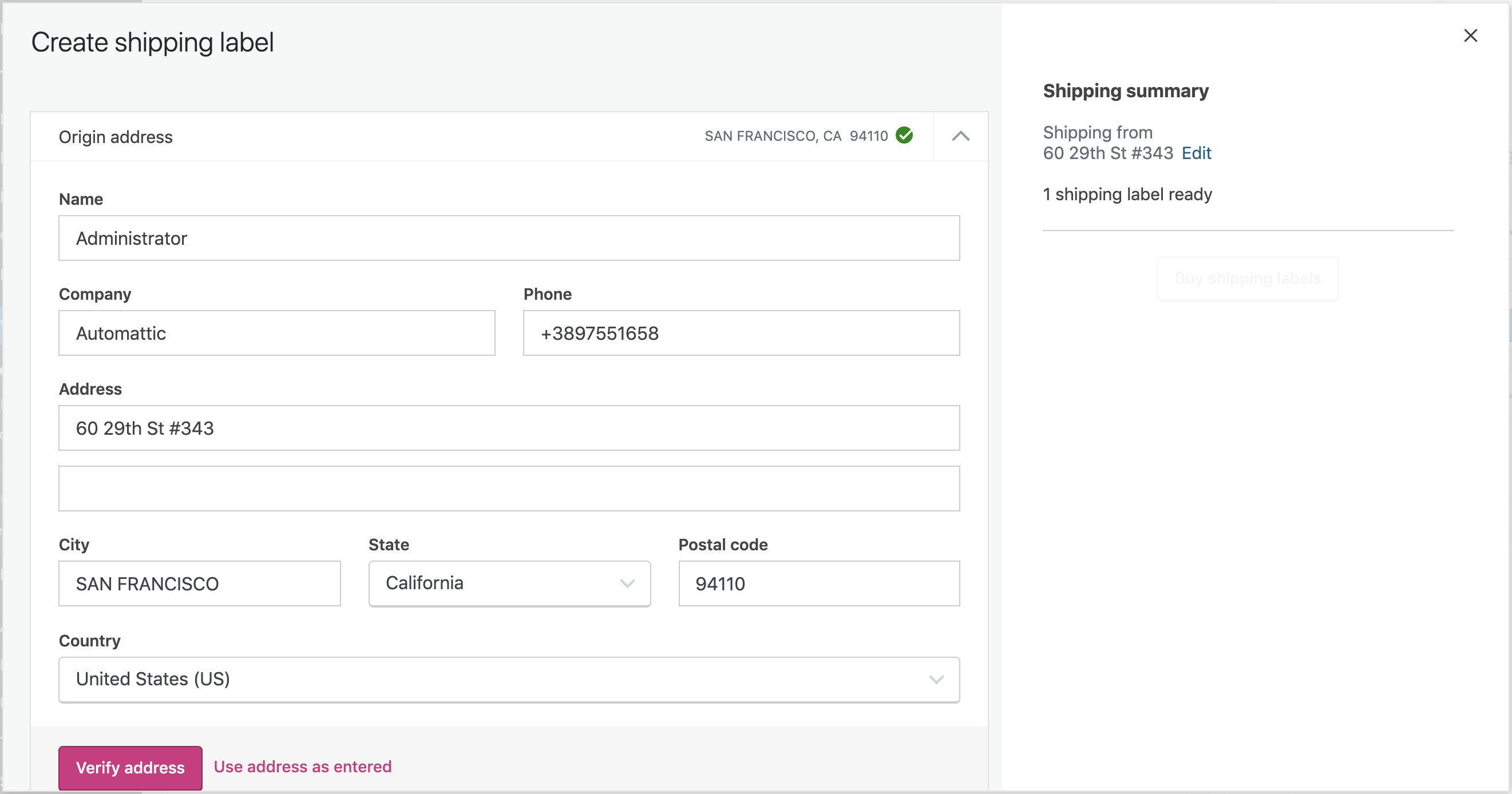
- Confirm the origin and shipping addresses, then select Verify address.
- If the order requires multiple packages, click the Move button to the right of the product(s) that should be moved to a separate package. Select between Add to a New package, Ship in original packaging, or another package (if already created), and click Submit to move the item. Confirm the Package details, or select packaging from the dropdown. Then select Use these packages.
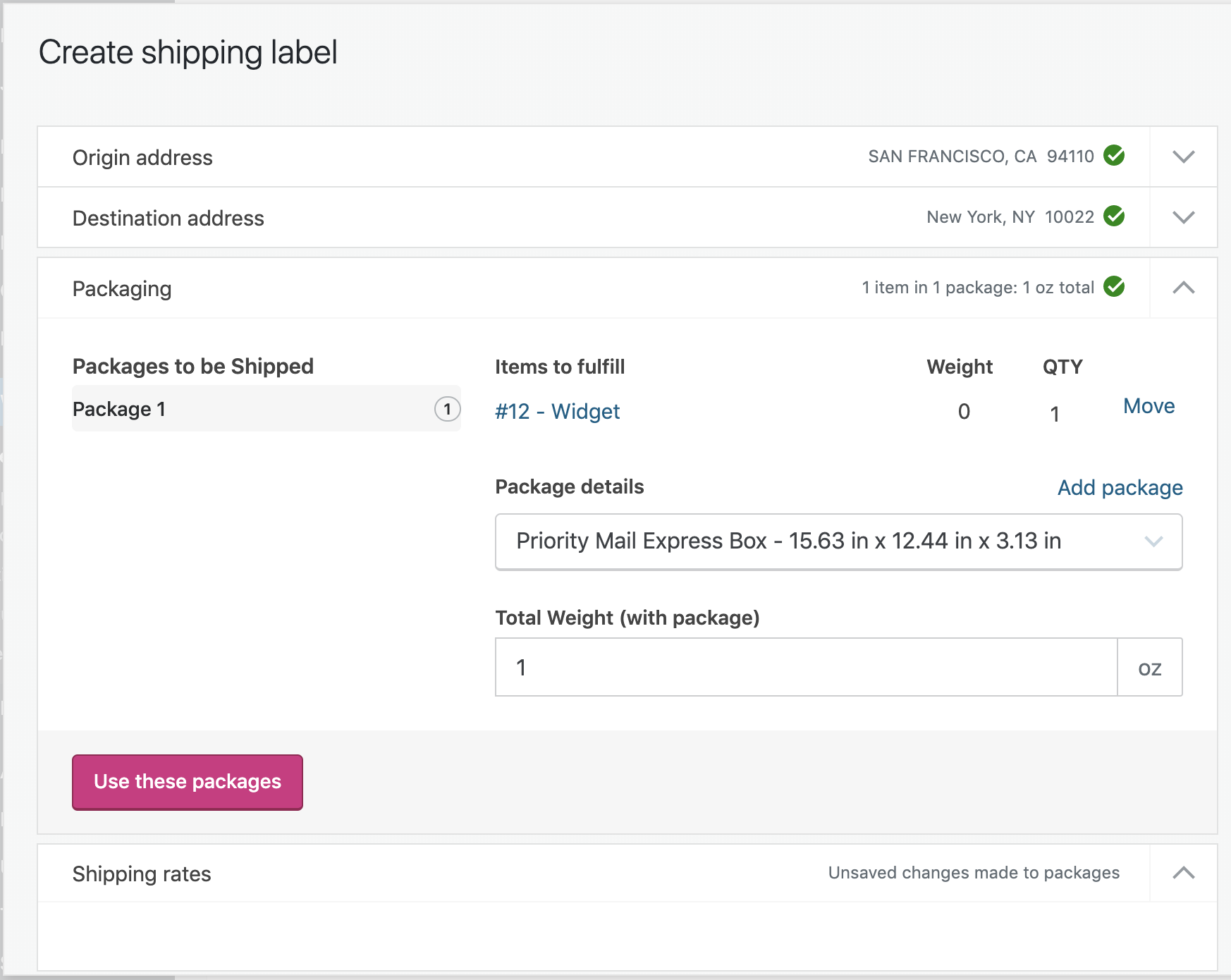 As of July 9th, 2023, USPS has implemented new regulations that require merchants to identify shipments of hazardous materials (HAZMAT). To ensure compliance, please follow these steps: If your shipment includes hazardous materials, choose the ‘Yes’ option under the ‘Are you shipping dangerous goods or hazardous materials?‘ question. Next, select the specific type of hazardous material from the provided dropdown menu. If you’re uncertain whether the product you’re shipping falls under the HAZMAT category, please use USPS’s search tool. WooCommerce Shipping does not currently support HAZMAT shipments through DHL Express.
As of July 9th, 2023, USPS has implemented new regulations that require merchants to identify shipments of hazardous materials (HAZMAT). To ensure compliance, please follow these steps: If your shipment includes hazardous materials, choose the ‘Yes’ option under the ‘Are you shipping dangerous goods or hazardous materials?‘ question. Next, select the specific type of hazardous material from the provided dropdown menu. If you’re uncertain whether the product you’re shipping falls under the HAZMAT category, please use USPS’s search tool. WooCommerce Shipping does not currently support HAZMAT shipments through DHL Express. - Select Shipping Rate and whether an Adult signature is required (optional).
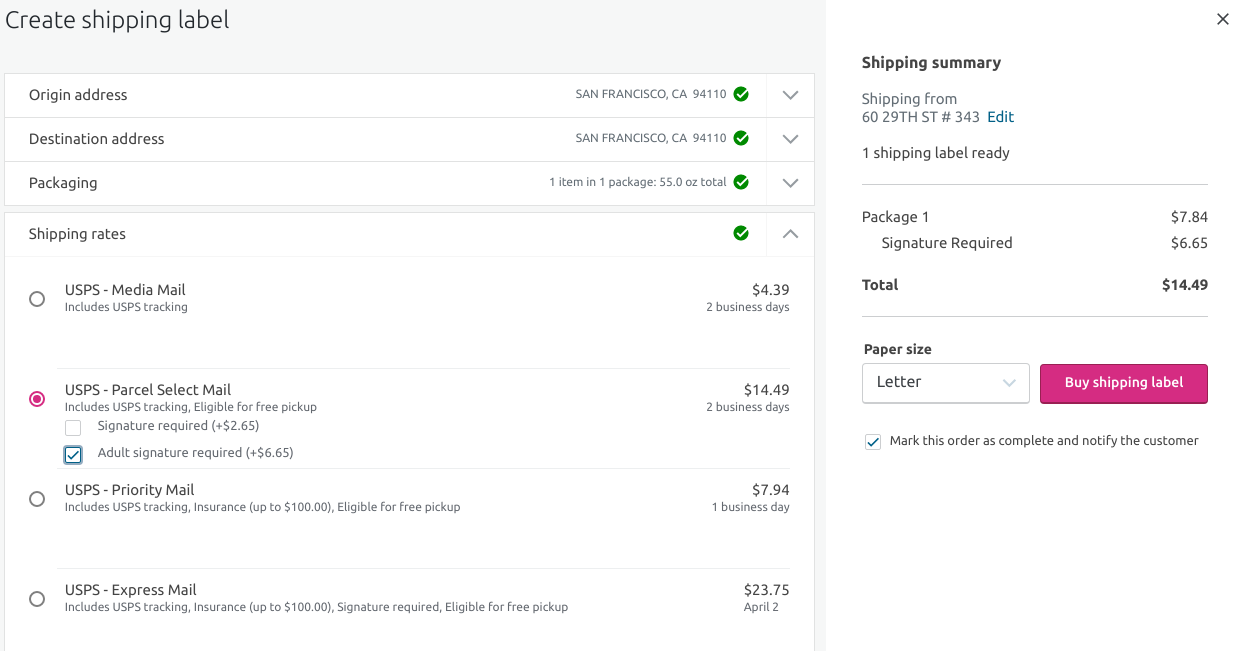
- Buy shipping labels or Add credit card. What you see depends on if you previously entered a payment method.
- Buy shipping labels: This means that you previously had a payment method on file at WordPress.com or added a credit card during setup above. You’re ready to proceed to the next step.
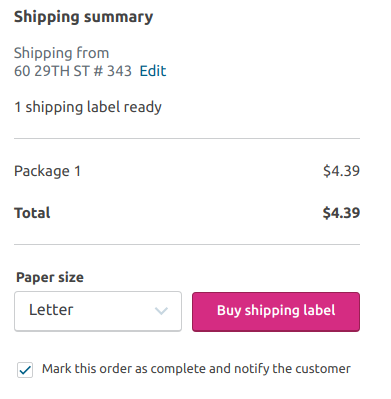
- Add credit card: This means you did not have a payment method on file at WordPress.com and skipped adding a credit card during setup.
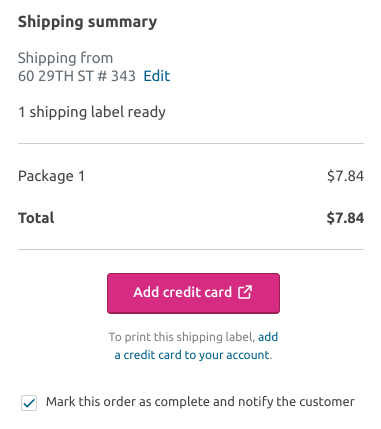 You will be taken to the Add Credit Card screen to complete all required fields and Save Card. Once a payment method is entered, the button changes to Buy shipping labels and you’re ready to proceed.
You will be taken to the Add Credit Card screen to complete all required fields and Save Card. Once a payment method is entered, the button changes to Buy shipping labels and you’re ready to proceed.
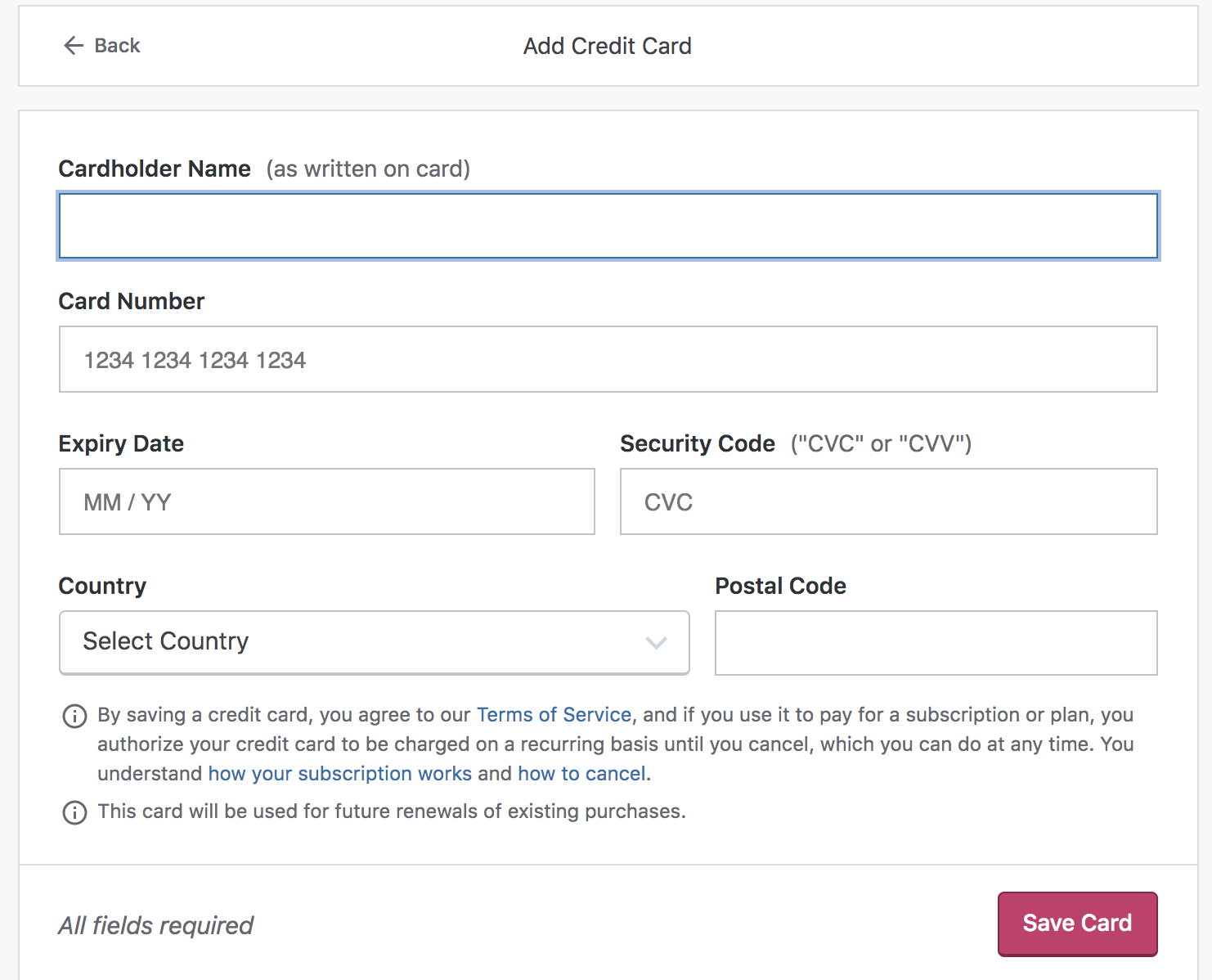 Should you change your mind later, you can Delete Card.
Should you change your mind later, you can Delete Card.
- Buy shipping labels: This means that you previously had a payment method on file at WordPress.com or added a credit card during setup above. You’re ready to proceed to the next step.
- View the shipping label in Print mode, after selecting Buy shipping labels and a display automatically appears. Note: Some browsers require you to select the Print button.
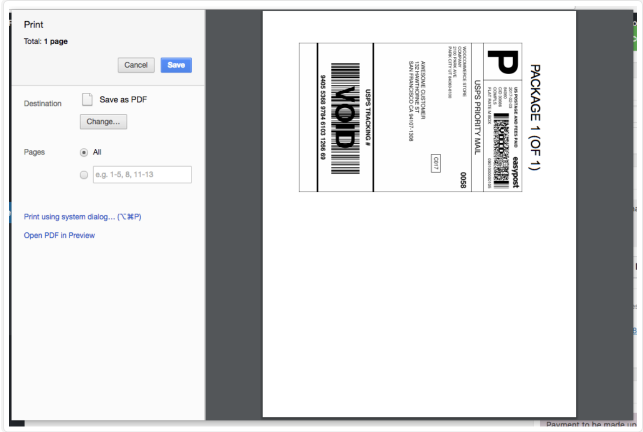
Printing a label if the shipping is international
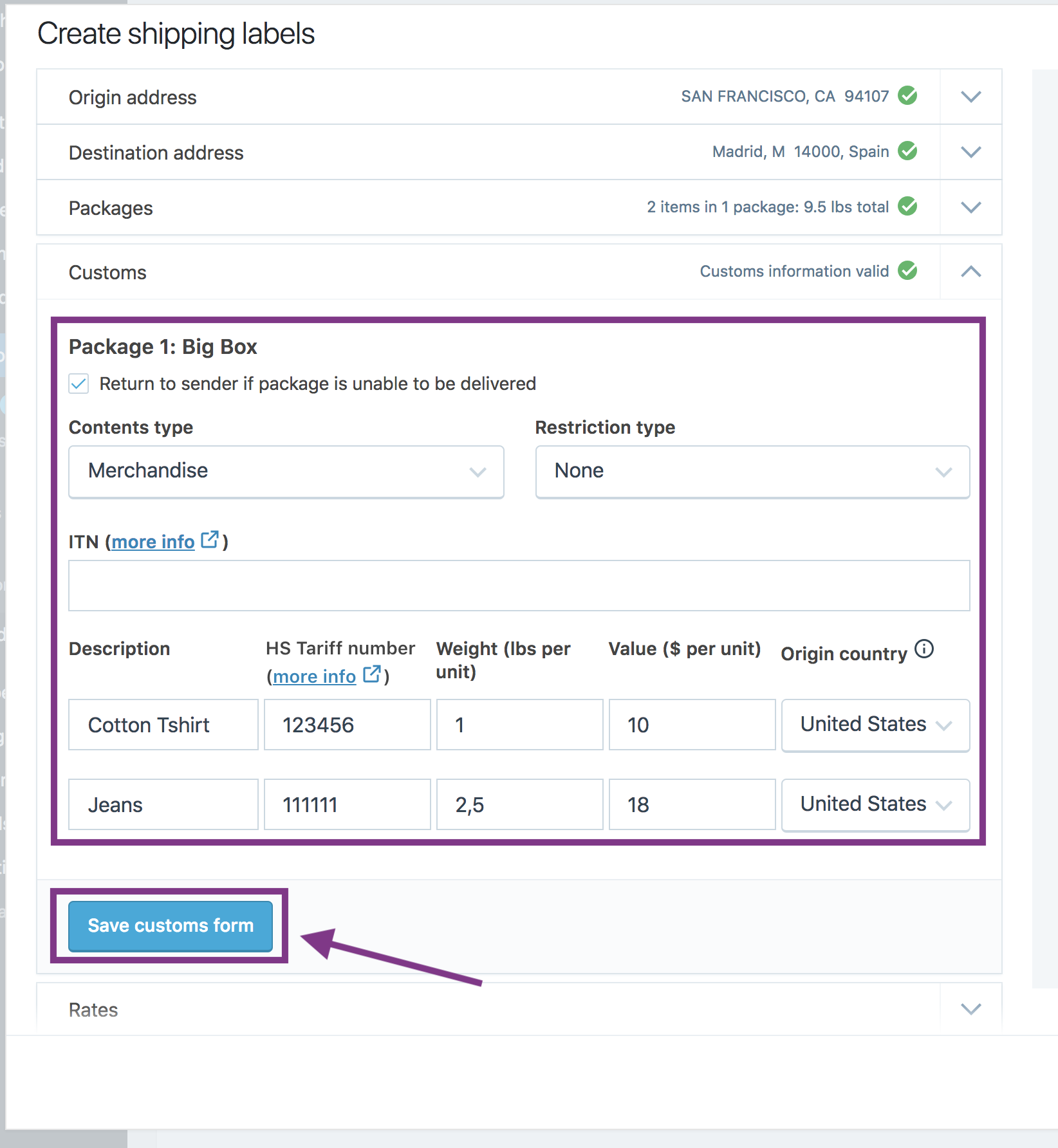
- USPS – For certain USPS international shipments, a single shipping label will be split into three parts (proof of payment, customs declaration, and dispatch note). In those cases, you’ll need to put the three parts, in order, inside a USPS-provided window pocket.
- DHL – For countries’ non-supported countries by DHL’s Paperless Trade, you need to print the customs documents. You’ll be prompted to print the custom document right after printing your label. You can always find and print the custom documents from your order page. Select the three ellipsis menu in the Shipping Label metabox. For countries supported by DHL’s Paperless Trade, WooCommerce Shipping automatically submits your customs information electronically for supported countries. You only need to print the shipping label.
Tracking information
- In Shipping Label metabox on the top of your order page, click on the Track Package button to find the tracking number and link.
- The Shipping Label metabox on the right display of your order page displays the tracking number for your shipment.
- The tracking number(s) will be included in the email sent to your customer when the order is marked “completed.”

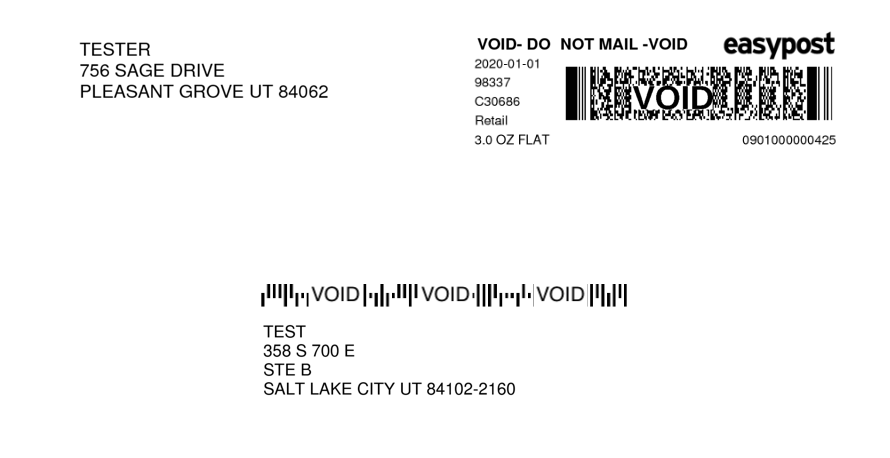
Reprint Shipping Labels or Request Refund
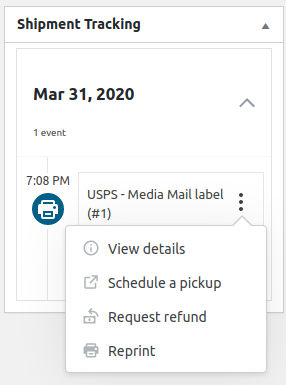
Schedule a pickup
- USPS – Free for packages when scheduled at the same time your mail is delivered by your letter carrier. For scheduling a pickup at a select time and day, you can opt for USPS’s Pickup on Demand® for a fee.
- DHL Express – Free

Label Reports
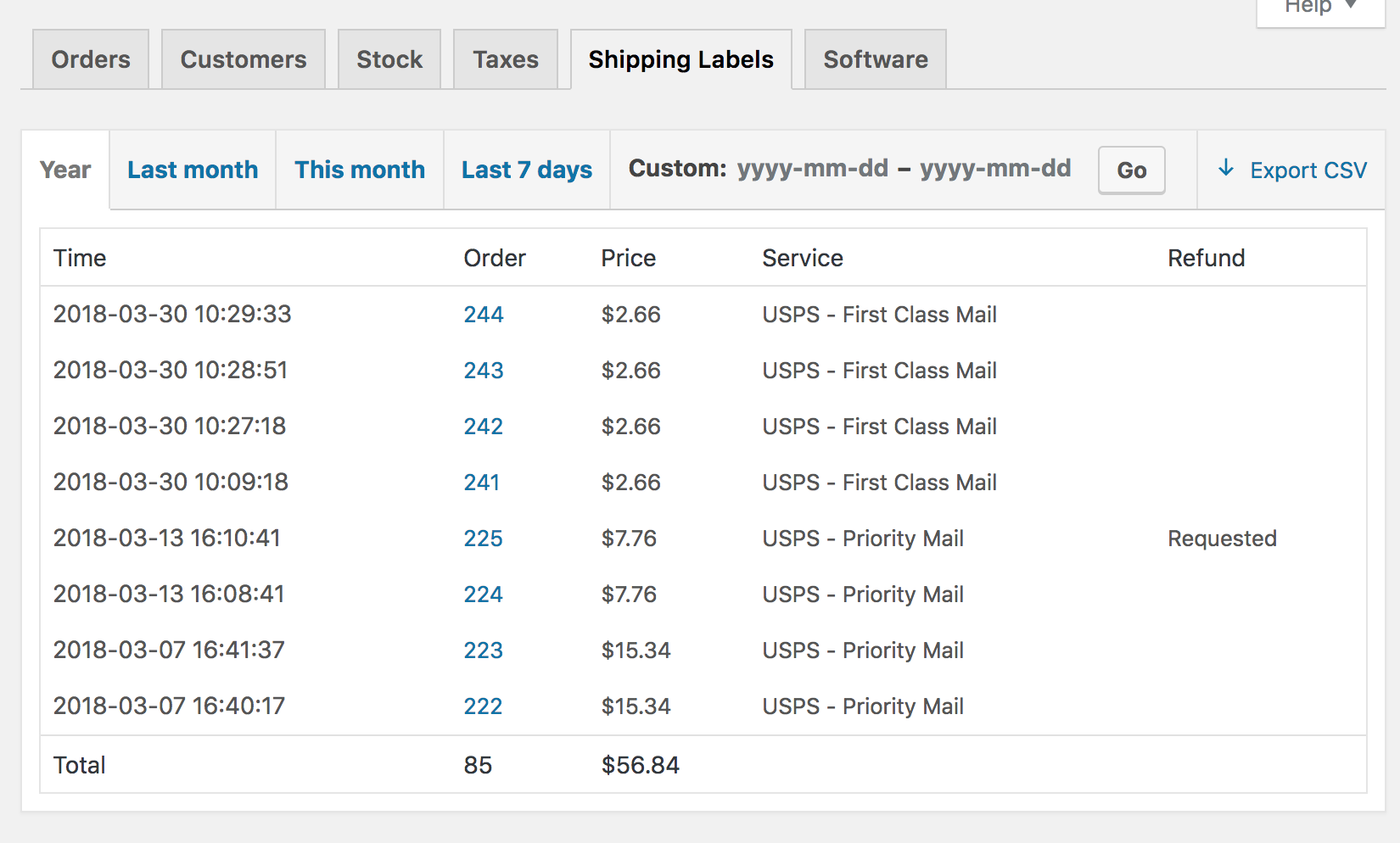
Live Shipping Rates (discontinued)
- Go to: WooCommerce > Settings > Shipping.
- Add a USPS or Canada Post shipping method to an applicable zone.
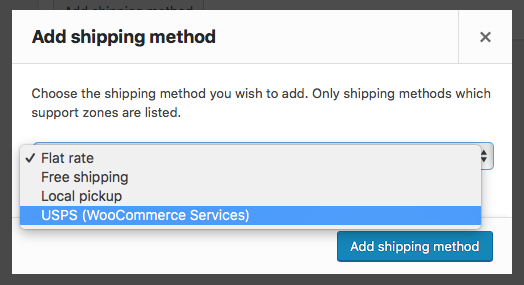 Note: USPS is only available for stores accepting US Dollars, and Canada post is only available for stores accepting Canadian Dollars.
Note: USPS is only available for stores accepting US Dollars, and Canada post is only available for stores accepting Canadian Dollars. - Name the shipping method to be displayed for your use, and enter the post code you are shipping from. The origin ZIP code will default to the value set in WooCommerce > Settings.
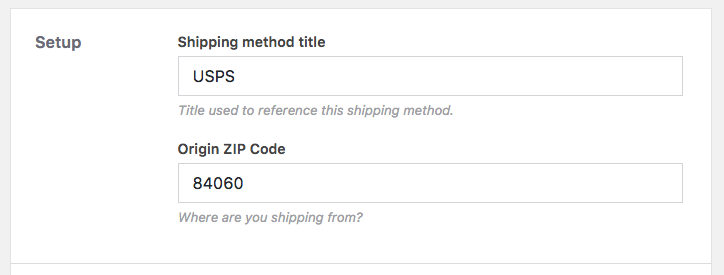
- Select the carrier services you want to offer. By default, Priority Mail services are selected. Enter any price adjustments, if applicable. Price adjustments can be useful to help cover your costs for shipping supplies. This will add an additional cost to the final shipping price, shown as one price to your customer.
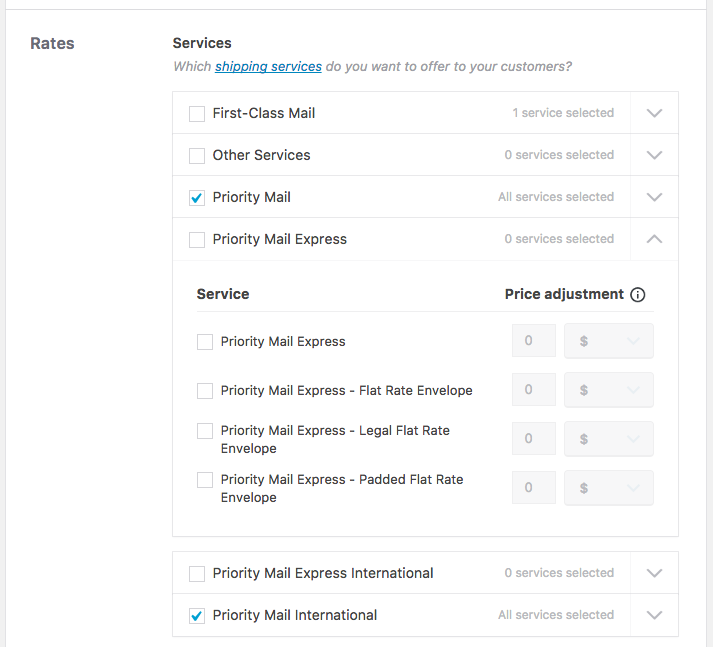
- Select which rates to offer customers.
- Enter a fallback shipping cost (optional) and what rate class you want to charge. This will allow the customer to check out if USPS can not return rates, charging the fallback rate instead.
- Retail rates are the standard rates that USPS charges for shipping. This is what you would pay if you take your package to a USPS post office for shipping.
- Commercial rates are the discounted rates available via a special agreement with USPS. If you select Commercial rates, your customers are charged the agreed-upon discounted rate.
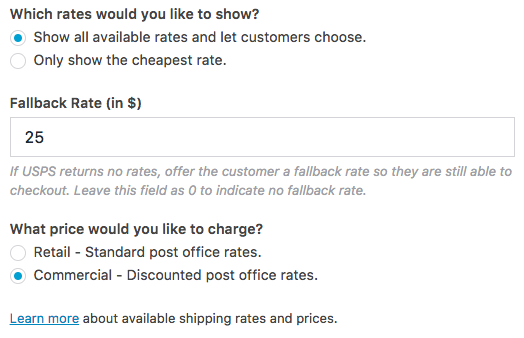

Troubleshooting
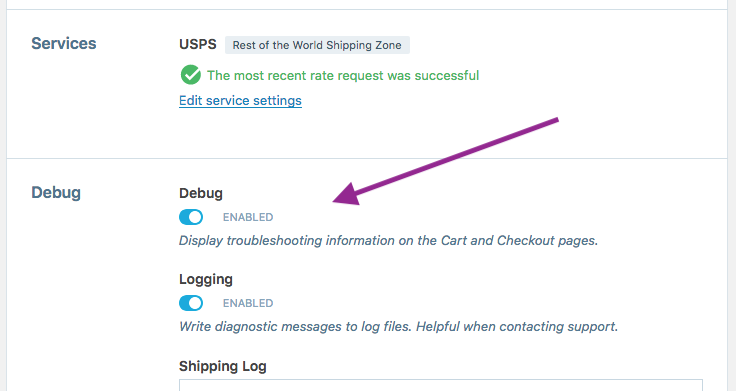
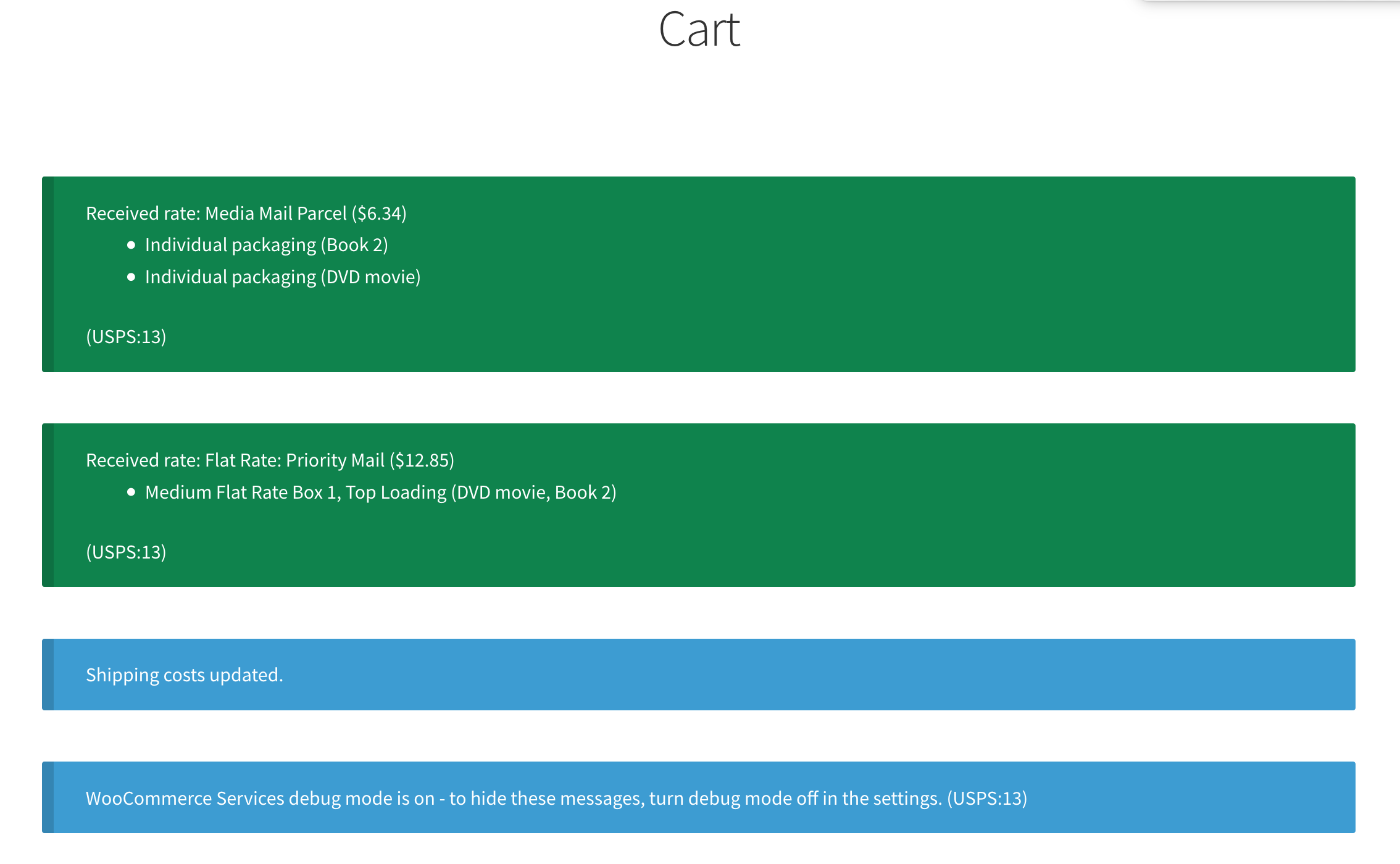
I’m asked to add a credit card to purchase labels, even though I’ve got a credit card on file.
“Unauthorized Invalid token” error
01-10-2018 @ 14:09:18 - Received (401): {"statusCode":401,"error":"Unauthorized","message":"Invalid token","attributes":{"error":"Invalid token"}}
01-10-2018 @ 14:09:21 - wcc_server_error_response Error: The WooCommerce Services server returned: Unauthorized Invalid token ( 401 ) (fetch_service_schemas_from_connect_server)
Reset the connection to WordPress.com by following this guide from our WooPayments documentation as the process is the same.
Unable to connect through Firewall
Unexpected server error notice when trying to print a shipping label.
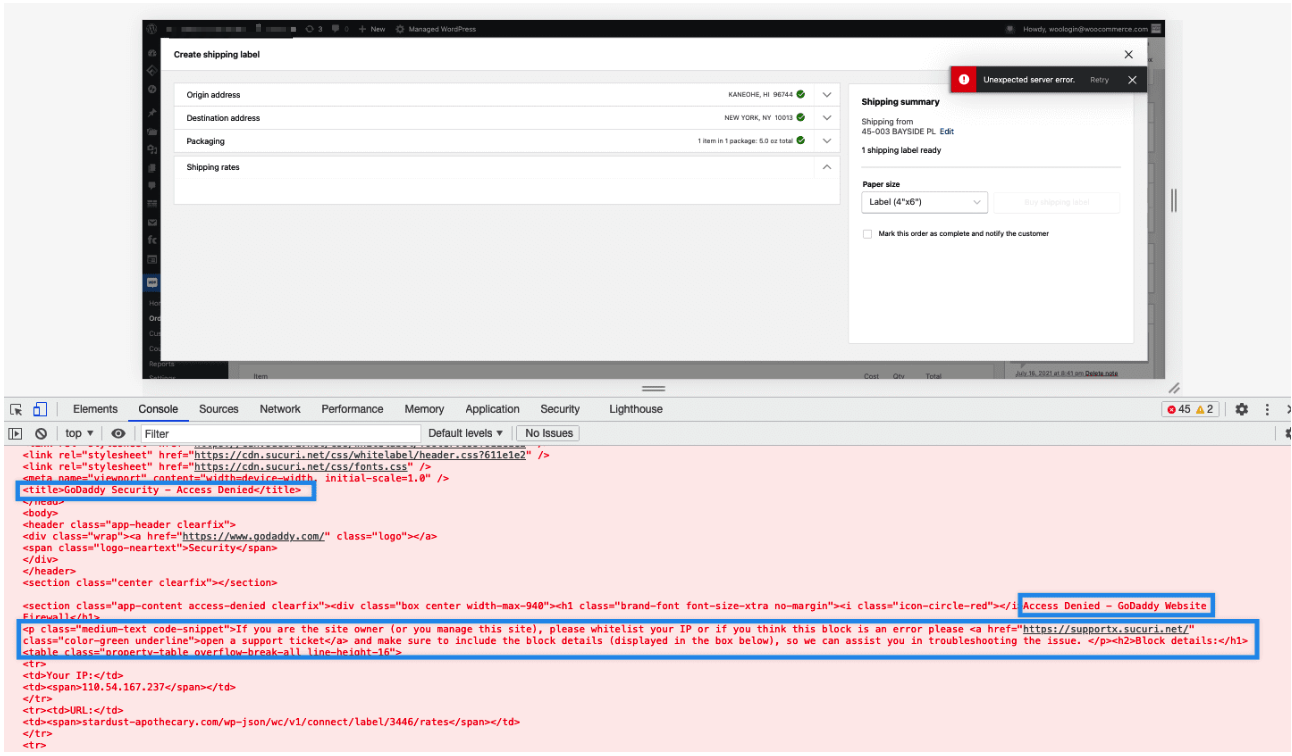
The Create Shipping Label button is missing from the Order Details screen.
- Your store is in the United States (including Puerto Rico, Virgin Islands, and other U.S. territories)
- Your store currency is US Dollars
- At least one product in the order “needs shipping” according to WooCommerce (typically means a non-virtual product)
This address is not recognized. Please try another.
Shipping Rates are not returned
Product is missing weight or dimensions
01-15-2018 @ 18:15:49 - Error. Unable to get shipping rate(s) for wc_services_usps instance id 25. (calculate_shipping) 01-15-2018 @ 18:15:49 - product_missing_weight Product ( ID: 37 ) did not include a weight. Shipping rates cannot be calculated. (calculate_shipping)Solution: Ensure that your products have weight and dimensions, then try again.
USPS or Canada Post shipping method is missing.
No USPS service available to Nigeria and Ghana.
Frequently Asked Questions
Why do I need to connect to WordPress.com?
Why do I need to enter my credit card?
Do I need special paper or a specific printer to print labels?
How do I order free supplies from carriers?
How to provide customers with a return shipping label for products to be returned
How to update Origin Address

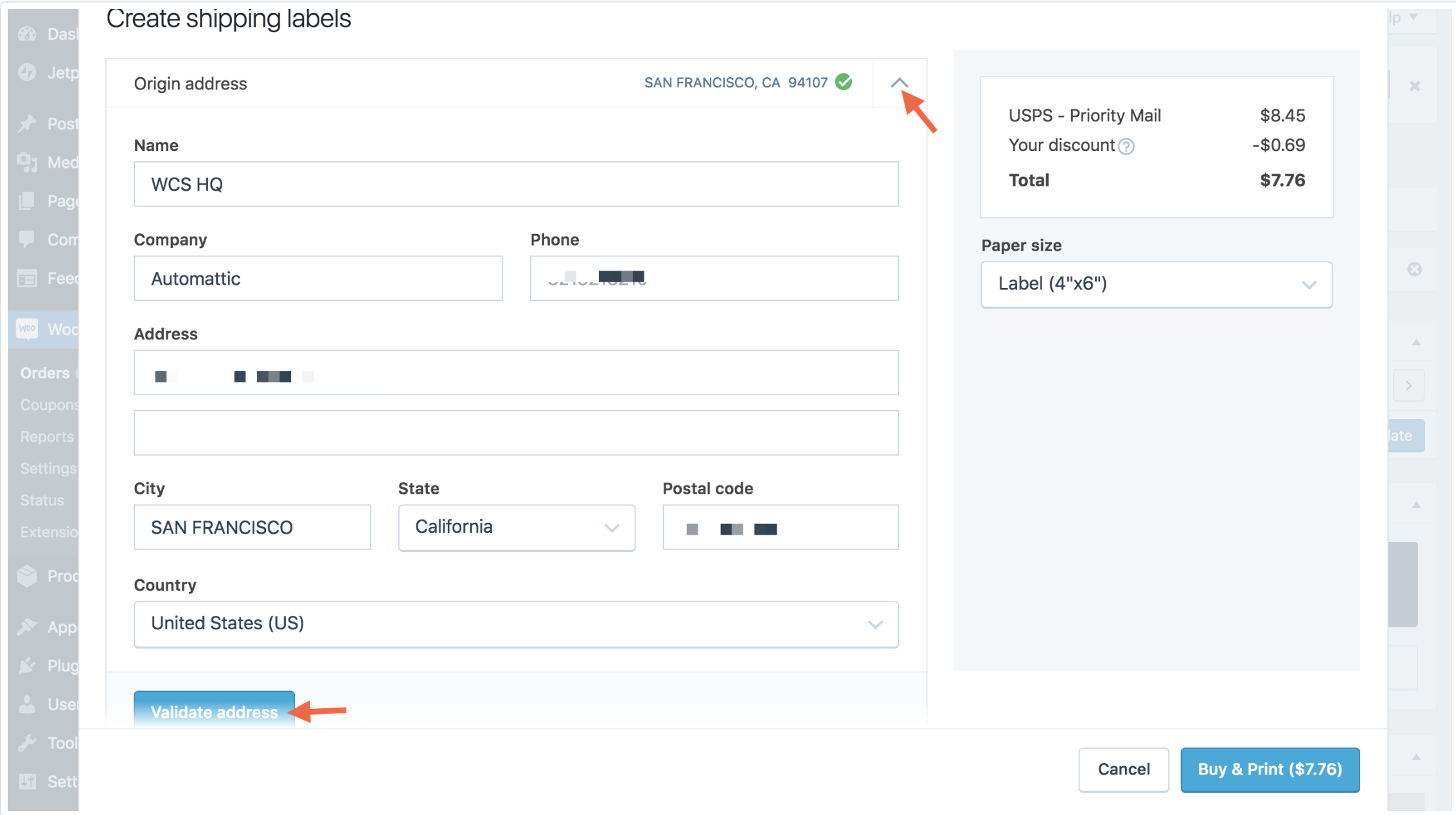
Bulk actions cannot be selected.
Is it possible to auto-create a USPS manifest?
What are the HS Tariff Numbers?
- Delays: Not classifying your products will cause the importing country to spend time manually classifying them on their end.
- Denials: Each importing government has its own unique restrictions in place to protect local markets. While there are some products that are perfectly fine to export in one market, they might very well be denied in another.
Can I buy and print shipping labels for US domestic and international packages?
Yes! You can buy and print USPS shipping labels for domestic destinations and USPS and DHL shipping labels for international destinations. Shipments need to originate from the U.S.Can I get discounts on labels?
DHL: Undelivered and unacceptable shipments
- required customs declaration isn’t made
- it contains prohibited items
- its packaging is defective or inadequate
- receiver fails to pay owed duties and taxes – Your customer will receive an email notification if duties and taxes are owed on the package.
- its shipping address is incorrect or not properly marked – DHL Express will contact your customer or you for more information.
What items are prohibited from being ship?
- USPS Domestic or International Shipping Prohibitions & Restrictions
- DHL Express Terms and Conditions of Carriage (see section 2: Unacceptable Shipments)
How do I submit an insurance claim for lost or damaged shipments?
- Tracking number.
- Copy of the waybill, if available.
- Documentation supporting the amount claimed- e.g. a vendor/supplier invoice and a retail invoice.
- If an item was purchased or sold via the Internet, documentation of that transaction is required e.g a PayPal receipt.
- Serial numbers, identifying marks, or other information unique to the specific item(s) claimed.
- Indicate if the claim is for missing content, lost shipment or damaged item.
- Description of the missing content, lost shipment or damage (attach photos if available). Include, the serial number or identifying mark, the number of units, and the claim amount for each item.
Flat Rate Shipping
Setup and Configuration
- Go to WooCommerce > Settings > Shipping > Shipping zones.
- Click the Edit button on the shipping zone where you want to offer this method.

- Inside the shipping zone, click the Add shipping method button.

- Then, select the shipping method and click the Continue button.

- Enter a Name that displays to customers in the cart and checkout pages.
- Select the Tax Status to determine whether tax is applied to the Cost.
- Enter the Cost for this option, to be applied to the entire cart.
- You can add additional costs per item to this field. See Advanced Costs below.
- You can keep the cost at $0.00 to disable Flat Rate, which can be useful if you configured Shipping Classes (see below).
- Click the Create button to finish.

Shipping Classes

- Per Class: Charge shipping for each shipping class individually.
- Per Order: Charge shipping for the most expensive shipping class.
Advanced Costs
- [qty] — Number of products in the cart
- [fee] — An additional fee. This fee has two optional arguments.
percent— A percentage based on total order cost.min_fee— A minimum amount. Useful when using percentages.max_fee— A maximum amount. Useful when using percentages.
Examples
10 + ( 2 * [qty] )— A base shipping cost of $10 plus $2 for each item in the cart.20 + [fee percent="10" min_fee="4"]— A base shipping cost of $20 plus 10% of the order total, which is at least $4.
How to set up Free Shipping for some products and Flat Rate for the rest

0 * [qty], no matter how many products from that class are added to the cart, the shipping cost will not increase.
However, products in the Expedited Shipping class will cost $20 per product from that class (because we’re using 20 * [qty]) while Regular Shipping class products and products that have no shipping class will cost $10 per product to ship (as we’re using 10 * [qty] for each of those options).
This means that if you have one product from each of our three shipping classes, the total Flat Rate cost will be $30 ($20 for one Expedited Shipping product, $10 for one Regular Shipping product, and $0 for one Free Shipping product).
Note: For this to work as described above, it is important to set the Calculation Type to “Per Class: Charge shipping for each shipping class individually” and that the Cost field is left blank.
Setting up Shipping Zones
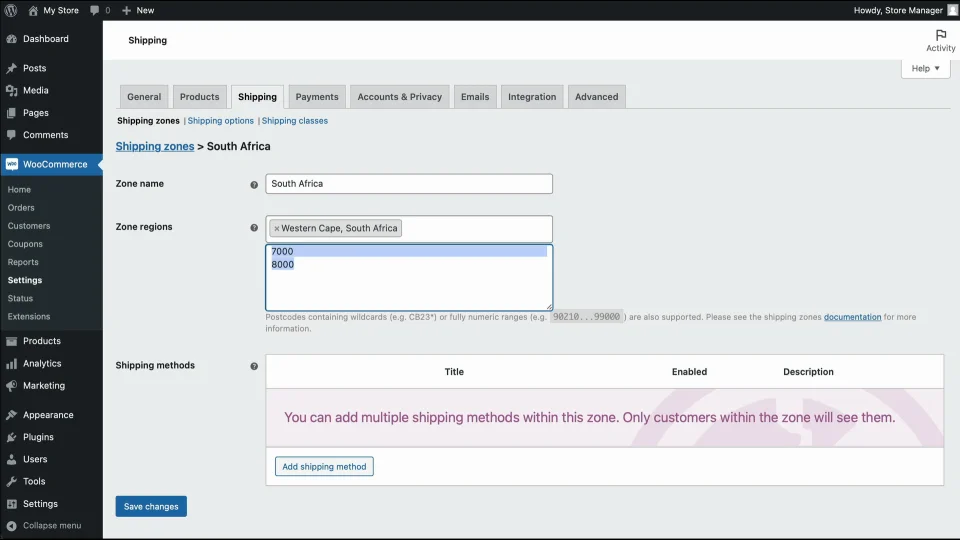
Selling physical products? You need to ship them!
To set up shipping in WooCommerce, you first set up shipping zones, then add methods to those zones, and lastly, rates to your methods. You can create as many zones as you like, and add multiple methods and rates to each zone.
Shipping Zones
A Shipping Zone is a geographical area to which you ship items. You can get as specific as you need, right down to regions and zip codes, or you can leave it more general – whichever suits you best.
Customers only see the methods available for their address and corresponding zone. Each customer matches only one zone.
For example, you could create these zones in WooCommerce:
| ZONE NAME | REGION | SHIPPING METHODS |
|---|---|---|
| Local | California ZIP 90210 | Local pickup |
| Domestic | All US states | 2 Flat rates named “standard” and “priority” |
| Europe | Countries in Europe | Flat rate shipping |
Add as many zones as you need, with each zone containing multiple shipping methods.
Adding and managing zones
To set up shipping zones, go to: WooCommerce > Settings > Shipping. If you don’t see Shipping as an option, go back to WooCommerce > General and take a look at settings at Shipping Location(s) – you may need to enable shipping settings there!
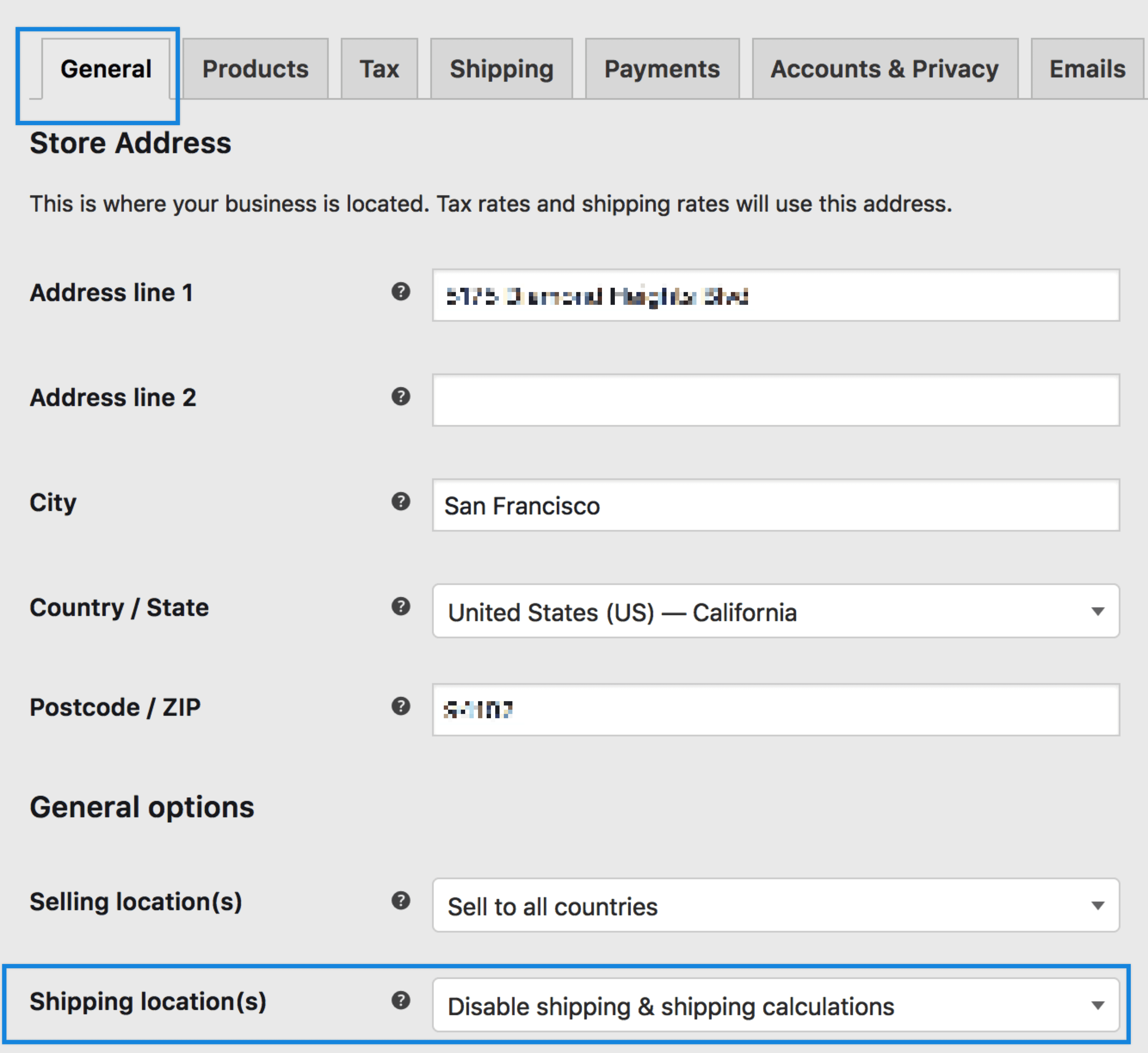
The first time you visit WooCommerce > Settings > Shipping, there is a prompt to add a new shipping zone, but you’ll also find the default Rest of the world zone.
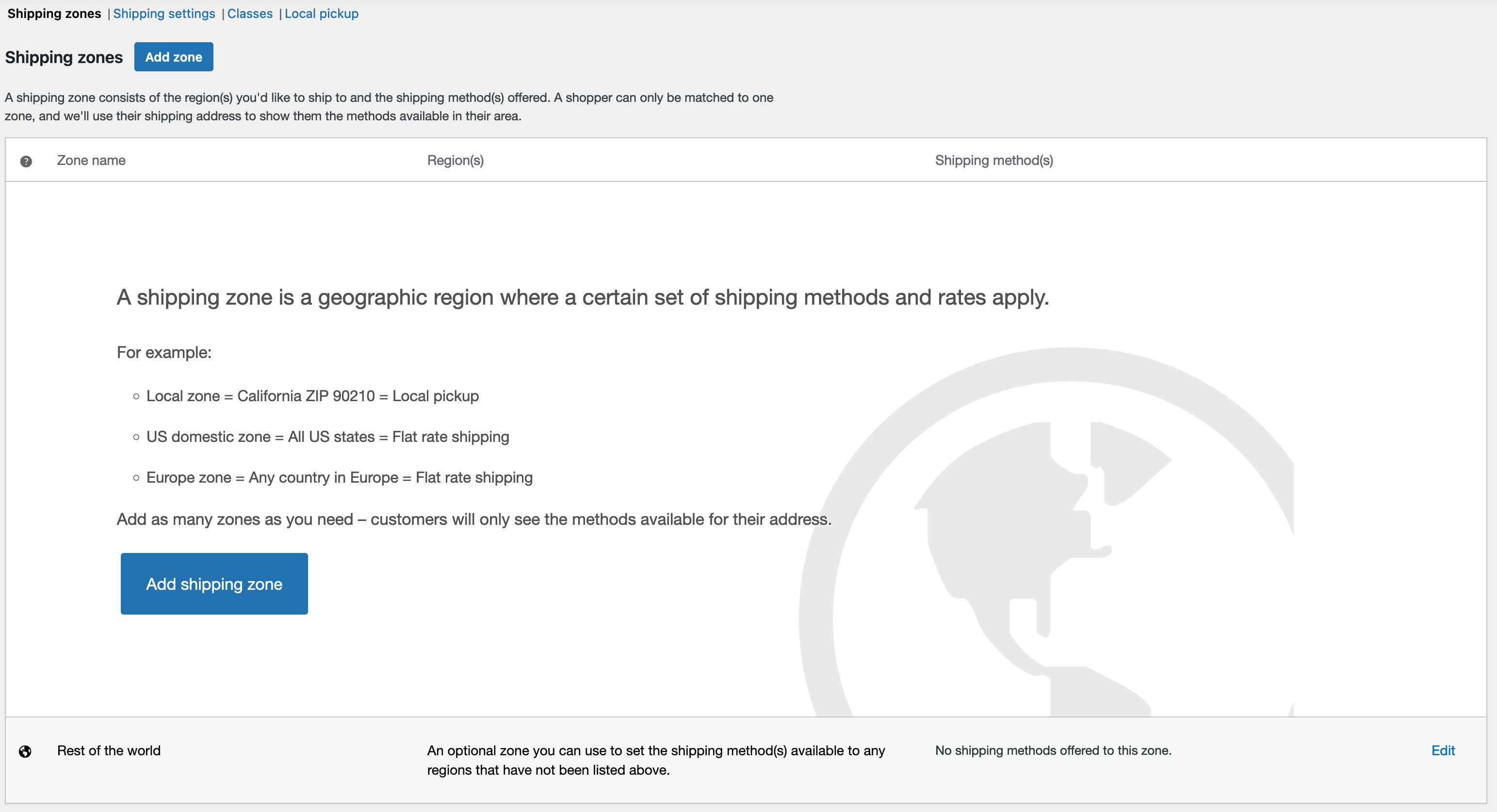
The Rest of the world zone is used for customers that do not match any of the shipping zones you add. Adding methods to this zone is completely optional, depending on your needs.
Since zones match from top to bottom, you can also exclude regions from shipping by adding a zone for that region and assigning no shipping methods to it.
Adding a new zone
- Go to: WooCommerce > Settings > Shipping > Shipping Zones.
- Click Add zone at the top.
- Enter a descriptive Zone Name, and select Zone Regions that apply. Regions can consist of: a) Countries, b) States, c) Continents.
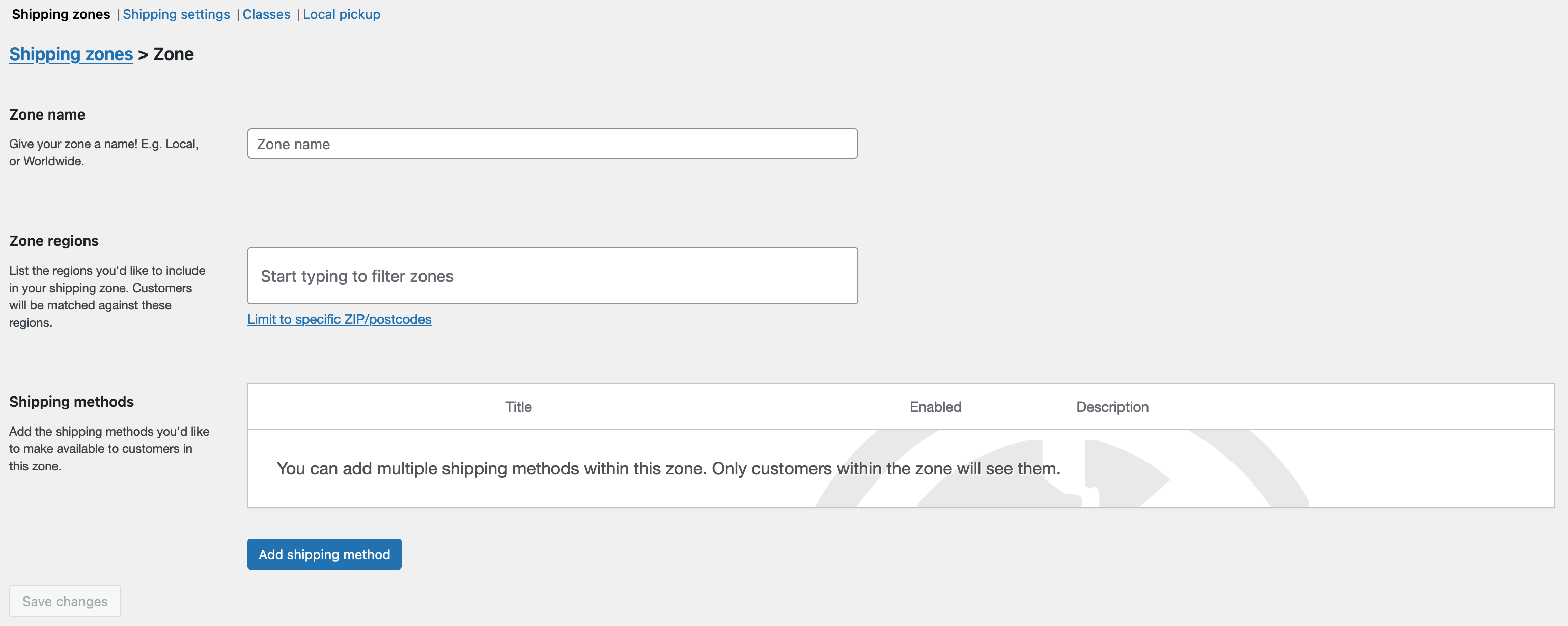
- Click Limit to specific zip/postcodes (if applicable) to further narrow which customers match this zone.

- Select which Shipping Methods are available to this zone.
- Click Save changes.
A wildcard can be used to capture all postcodes that share the same beginning, so it is the recommended option for postcodes with non-numeric characters (e.g., 902* would capture 90210 and also 90288-1234; CB23* would capture CB23 1EX). Using wildcards in numeric ranges isn’t supported.
In the below example, we created three zones – Local, Domestic, and North America – to demonstrate how zones can be set up.
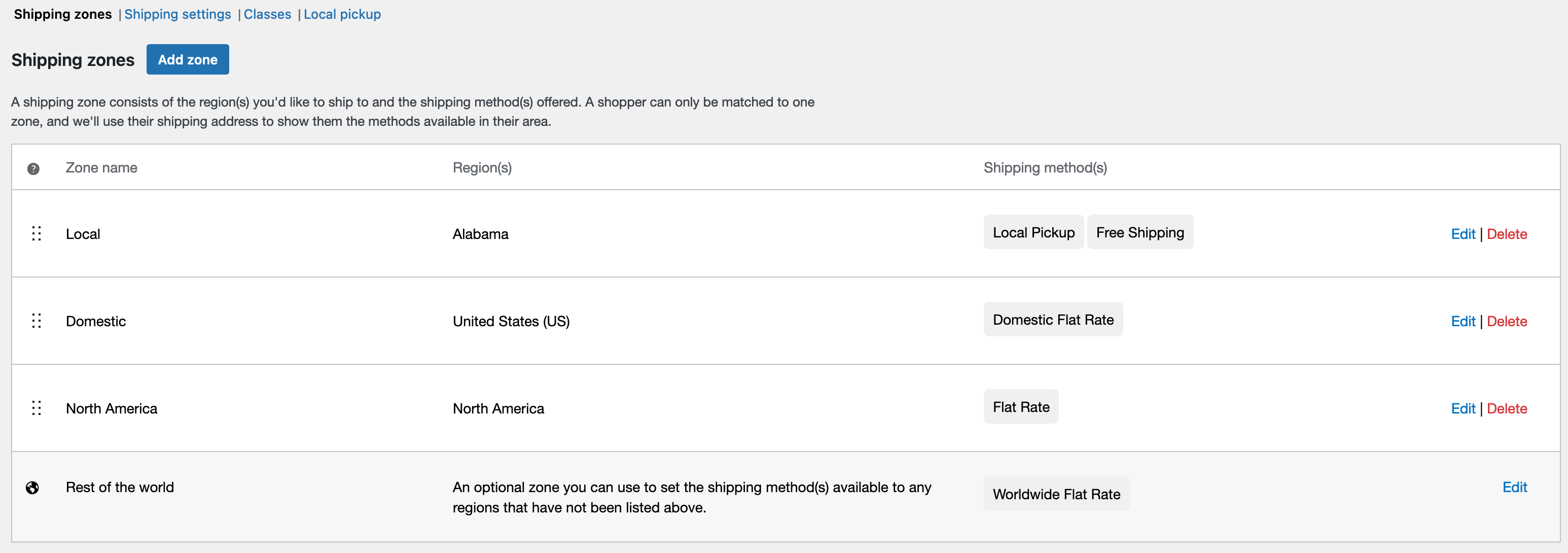
Sorting shipping zones
Shipping zones match customer address from top to bottom — the first to match the customer address is always used. If no custom zones match, then the Rest of the world zone is used.
To sort and reorder zones:
- Go to: WooCommerce > Settings > Shipping > Shipping Zones.
- Click and hold on the far left handles and drag the shipping zone.
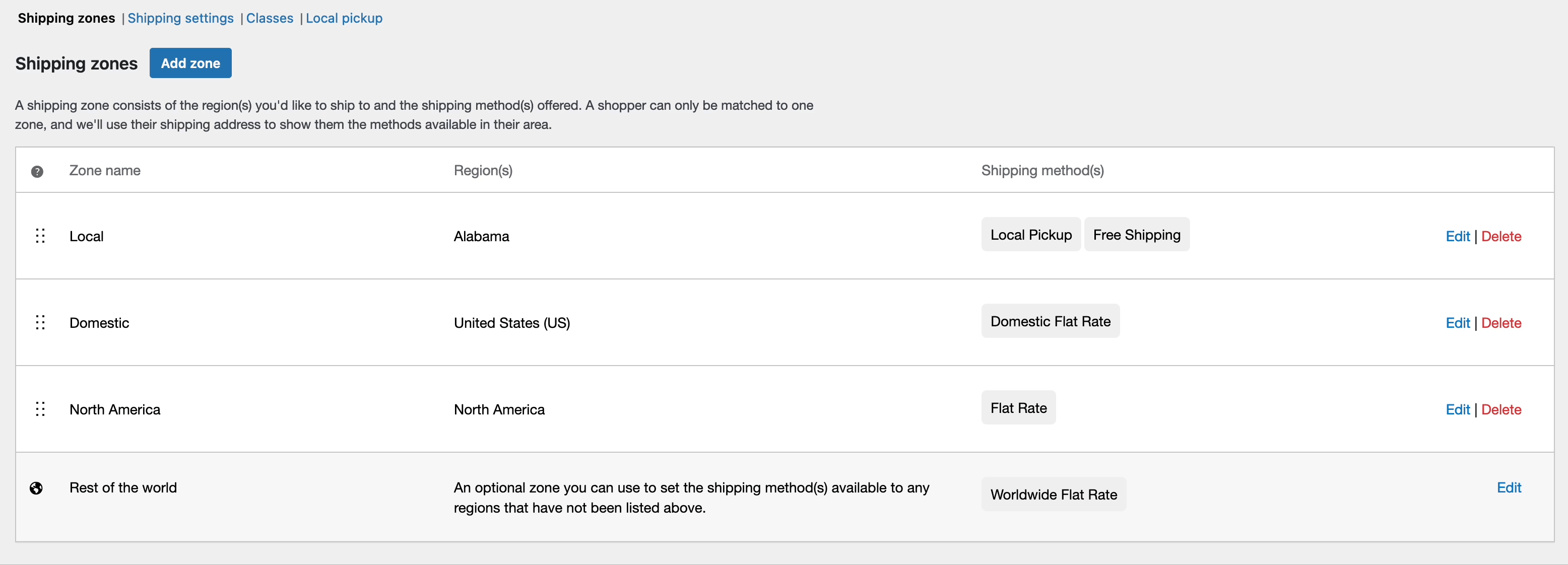
- Click Save changes to finish.
Editing and deleting shipping zones
- Go to: WooCommerce > Settings > Shipping > Shipping Zones.
- Find the Edit and Delete buttons on the right side of the shipping zone.

- Click the Delete button to eliminate the shipping zone.
- Click the Edit button to revise the name, regions, or shipping methods. Click the Save changes button to finish.
Adding shipping methods to zones
- Go to WooCommerce > Settings > Shipping > Shipping zones.
- Click the Edit button on the shipping zone where you want to add a shipping method.

- Inside the shipping zone, click the Add shipping method button.

- Then, select the shipping method and click the Continue button.

For more information about configuring the core shipping methods, see the following related docs:
| Local Pickup | Documentation |
| Flat Rate Shipping | Documentation |
| Free Shipping | Documentation |
Disabling and removing shipping methods from zones
- Go to WooCommerce > Settings > Shipping > Shipping zones.
- Click the Edit button on the shipping zone from which you want to remove a shipping method.

- Click the switch under the Enabled column to disable the shipping method.
- Click the Delete button to eliminate the shipping method.

Control the shipping method selected by default
The default Shipping Method for customers is the top listed, enabled shipping method in the zone that they match. Check the Sorting shipping zones section to learn how to reorder shipping methods.
You can also control how shipping methods are ordered in the cart page, in the same screen. All the selected shipping methods will be sorted in the cart page, in the same order you followed, to arrange them in this screen.
How zones work for customers
Using these shipping zones and methods:

- In the 90210 zip code in California, we offer Local Pickup and Free Shipping.
- In the United States, we offer a Domestic Flat Rate.
- In Canada and U.S. regions, we offer a different Flat Rate.
- For the rest of the world, we offer yet another Flat Rate.
Free Shipping

Free shipping is a great way to encourage customers to spend more. For example, offer free shipping on orders over $100.
Setup and Configuration
- Go to WooCommerce > Settings > Shipping > Shipping zones.
- Click the Edit button on the shipping zone where you want to offer this method.

- Inside the shipping zone, click the Add shipping method button.

- Then, select the shipping method and click the Continue button.

- Enter a Name that displays to customers in the cart and checkout pages.
- In Free shipping requires, you can select what is the requirement to offer free shipping:
- No requirement — Free Shipping is offered to all customers
- A valid free shipping coupon — Free Shipping is available if the customer uses a coupon that offers free shipping (see below: Create Free Shipping Coupons).
- A minimum order amount — Free shipping is only available if a minimum amount is spent. Set this amount in the Minimum Order Amount field, which will appear if you choose this option.
- A minimum order amount OR a coupon — Free shipping is available if a minimum amount is spent or the customer uses a coupon that offers free shipping.
- A minimum order amount AND a coupon — Free shipping is offered only if a minimum amount is spent and the customer uses a coupon that offers free shipping.

- When any of the Minimum order amount options is selected, an additional checkbox will appear: Apply minimum order rule before coupon discount.
- If the box is unchecked, the order amount after a coupon discount will be compared to the Minimum order amount to determine if Free shipping should be offered.
- If the box is checked, then the order amount before a coupon discount will be used instead.
- Click the Create button to finish.
Example: Coupon discounts and Minimum order amount
You have set $20 as the minimum order amount for free shipping eligibility, your customer has a product of $25 in the cart, and they also have a coupon that gives $10 off:
- If “Apply minimum order rule before coupon discount” is unchecked — The order amount is $25 – $10 = $15. The customer will not get free shipping according to the minimum order amount rule.
- If “Apply minimum order rule before coupon discount” is checked — The order amount is $25 and the $10 discount is ignored. The customer will get free shipping according to the minimum order amount rule. The coupon discount will still be applied.
Create Free Shipping Coupons
1/ Create a coupon.
- Go to WooCommerce > Coupons.
- Select Add Coupon.
- Select Allow Free Shipping.
- Publish.

More info at: (Coupon Management).
2/ Enable free shipping for coupons.
- Go to the shipping zone where you added the Free Shipping method in the previous step.
- Click the Free shipping method
- Select the option A valid free shipping coupon from the dropdown.
Customers can now use the coupon to get free shipping.

